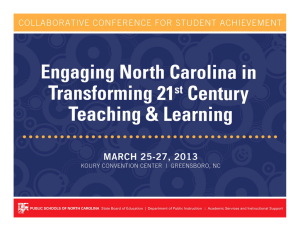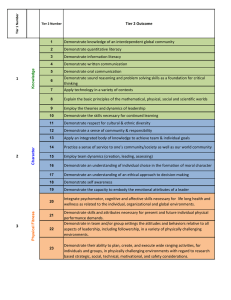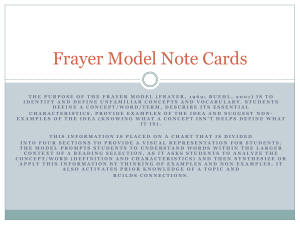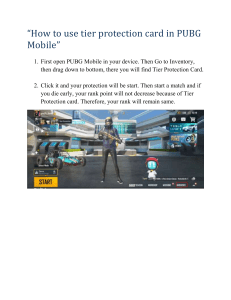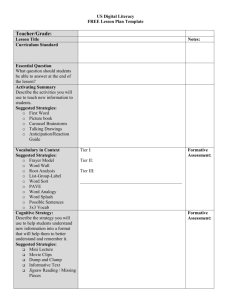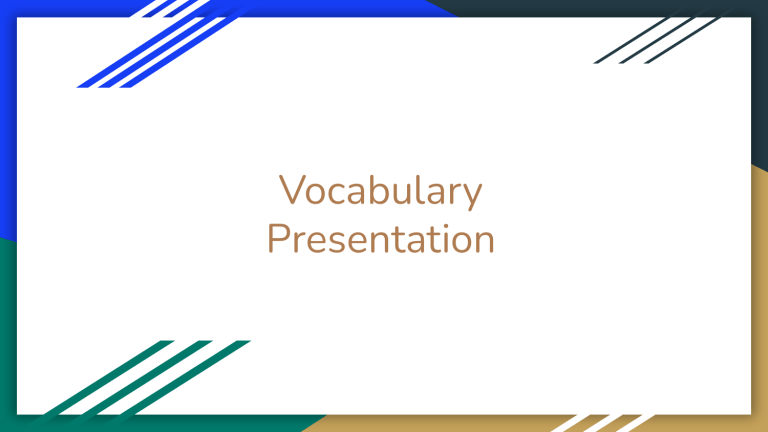
Vocabulary Presentation Effective Literacy Support and Vocabulary Instruction Part A Three Teaching Strategies Utilized in My Classes Strategy 1- Teaching Tier 2 and Tier 3 Vocabulary Utilizing Maps and Drawing ● According to the video, “How to Teach Vocabulary Acquisition”, students need multiple avenues to express the new tier 2 and tier 3 vocabulary, especially content specific vocabulary, which they are learning. I have used these strategies successfully in the classroom. ● In 6th Grade World History, while learning about Mesopotamia, we define Mesopotamia as “Meso” Greek for in the “middle” and “Potamia” for “water” in student notebooks as a starter activity. Strategy 1- Tier2 and Tier 3 VocabularyUtilizing Maps and Drawing ● Afterwards, students are given maps of Mesopotamia in which they label the Tigris and Euphrates Rivers and color them blue, label the land in the middle as the Fertile Crescent and Mesopotamia and color it green, and then students redefine Mesopotamia in their own words at the bottom of the map. ● The following week they are give a continents and oceans map and told to also label Meso-America, or Central America, with a rehearsal of what “Meso” means and with a description of what Meso-America is, as well as where it is. Strategy 1- Teaching Tier 2 and Tier 3 Vocabulary in Content Area ● As stated in “How to Teach Vocabulary Acquisition”, this allows students the opportunity to: * learn from a provided description and explanation. * acquire knowledge from artistic creation while using the word properly. *engage in periodic activity utilizing the new vocabulary. *discuss the term with one another and as a class. Drawing and Labeling Mesopotamia Utilizing Vocabulary Strategy 2- Content Area Vocabulary Learning“Many Forces” ● ● ● ● ● As suggested in the Content Area Vocabulary Learning Article, researchers advocate strategies which utilize “many forces” to teach the acquisition of content vocabulary. I am successfully using this strategy in my class by both reading to my students with a wide variety of informative material and having students read aloud and discuss what we, as a class, are reading in small groups and as a class. As advocated by the article, I also have a small but diverse and growing room library. We emphasize incorporating newly acquired vocabulary in class discussions, writing assignments, and in projects. I also support the acquisition of new vocabulary by keeping a word wall. Word Wall Strategy 3-Four Components of Teaching Literacy in Content Areas - Frayer Model ● According to Edutopia’s “How Important Is Teaching Literacy in All Content Areas”, it is critical for students to acquire content vocabulary through four primary areas which are reading, writing, speaking, and listening. ● Often for vocabulary which I know will be essential to the student, I use the Frayer Model Graphic Organizer. Strategy 3-Four Components of Teaching Literacy in Content Areas - Frayer Model ● When studying the Agricultural Revolution, we used a Frayer Model or Four Square Model to expound on the word “revolution”. Student worked in pairs while defining the word from a reading text, used a word in a sentence, wrote synonyms for the word, and the drew a picture to represent the word. Afterwards students shared their work as a class. ● In this activity, students had to read, write, speak, and listen to develop and understanding of the word “revolution.” Frayer Model Part B Three Teaching Strategies Which I Would Recommend to Colleagues First Recommendation: “How to Teach Vocabulary Acquisition” Video ● ● ● I believe his six step model is an excellent place to start helping students to develop Tier 2 and Tier 3 vocabulary, and with repeated use, this allows students an ease in developing context and content specific vocabulary, especially in areas such as social studies. With repeated use, students become more confident in the meaning, purpose, and their understanding of this specific vocabulary. Then they are also able to begin to link this new vocabulary with synonyms and antonyms, especially if this is frequently rehearsed in class. I truly believe the Frayer Model is a great way to utilize this approach to developing new vocabulary, also another effective method is keeping a notebook and drawing as well as writing in the notebook. Frayer Model Second Recommendation: Edutopia’s “How Important Is Teaching Literacy in All Content Areas?” ● One of the hyperlinked recommendations in this article was “Previewing the Text” using “Thieves” strategy, which stands for previewing the title, headings, introductions, visuals and vocabulary, the end of the chapter questions, and the summary. ● After evaluating the text utilizing these techniques, then students will vocalize and explain how they “stole” the information from the text using “Thieves”. ● This previewing technique seems to be a great way to evaluate the text and glean much from the text before beginning to read as a class, allow students to access previous knowledge. Third Recommendation: Graffiti Conversations from Edutopia’s “How Important Is Teaching Literacy in All Content Areas?” ● ● ● I find graffiti conversations an excellent tool, because often students have an ease with drawing as opposed to writing. When used properly, students can then take what they have drawn and label it using both words, literacy, and the artistic expression of drawing. This is an excellent assessment tool to evaluate just how much students have understood pertaining to the topic and the vocabulary. I use this strategy as the last page to be completed in student notebooks prior to turning in the notebooks for a unit grade. Often these ideas encompass the large content vocabulary displayed and discussed in the unit. Graffiti Conversations
